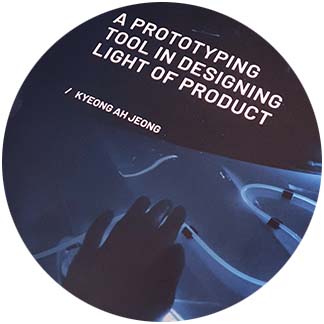After having conducted a number of light design projects with industry for four years, she finally and successfully documented the “herstory” in a Ph.D. dissertation. Entitled as, “A prototyping tool in designing light of product [제품의 빛을 디자인하기 위한 도구 개발 및 활용]”, the dissertation includes not only the scientific information but also practical know-how how designers can solve light related issues in the design process. As of the upcoming March, she starts her professional career at a UX design team of home appliances in Samsung Electronics. Congratulations!
Abstract
Although the light has become a critical design element for products, the lighting design process remains largely unexplored in the product design. Given this background, this dissertation aims to develop a lighting prototyping tool for designers to support the exploration of lighting design in the early design stage as well as refinement to optimize the lighting attributes. In particular, this study tries to figure out the role of lighting prototyping tools desired by designers and to discover the practical value of the tool. To achieve the research goals, a literature study on lighting properties was conveyed, and existing lighting design methods were reviewed. The physical and perceptual features of lighting were classified into tangible and intangible aspects, and then the design brief of the lighting prototyping tool was identified. Named as c.light, the tool was comprised of physical component— lighting emitting modules, a control module with Bluetooth connection, shape fixation modules, and lighting diffuser parts—and the android based mobile application. C.light enables users to create and manipulate lighting in terms of luminosity, chromaticity, and temporality.
To investigate the user experience of the c.light, two sessions of creativity workshops were carried out with domestic and international designers. The participants in both workshops explored the value and effect of lighting as a form factor of a product. The workshop unfolded three major findings: First, the tool supported the fabrication of the lighting properties. It reduced the gap between design intention and the actual outcome through explorative and inverted design procedures; Second, simultaneous manipulations of tangible and intangible lighting properties occurred iteratively; Last, the tool easily led the workshop into a collaborative atmosphere. Also, participants benefited from the c.light in the learning of lighting as well. In addition, in order to figure out the distinctive characteristics in contrast with the conventional ideation method, c.light was compared with sketching. In spite of noticeable advantages of c.light, it showed limitations in the expression of diverse forms and in archiving of selected lighting settings.
The advancements in physical components and mobile applications were implemented in a customized manner along with a series of case studies in industry-academia projects. The tool supported the shaping of lighting by using diverse forms of the diffuser. An LED with a structured cover, optical fibers, and LED mounted diffuser panel generated a point light with pattern projection, flexible line lighting, and luminous surface, respectively. In mobile applications, buttons were added to retrieve previous lighting selection. When a detailed control over the lighting choice was anticipated, discrete adjustments of R, G, B, or W channels were offered. The case studies dealt with passenger cars, heavy vehicle(bus), residential space, refrigerator, and clothing care system. According to the stage of lighting design, the case studies are grouped into two—lighting exploration and lighting refinement. Each case study resulted in reflections and insights, and the design requirements were finally derived. Based on attempts at making tools and lessons from case studies, this study provides methods and evidence to be facilitated by product designers to explore and elaborate on the design of product lighting.


